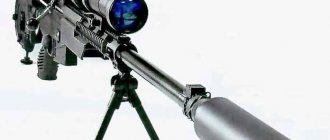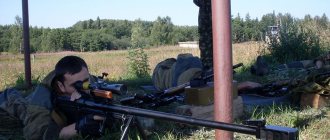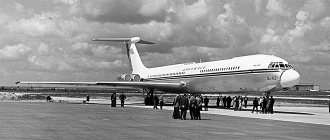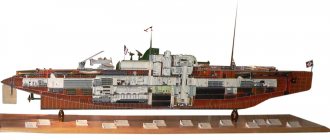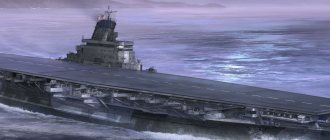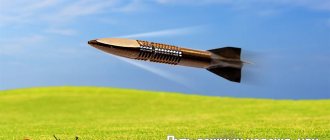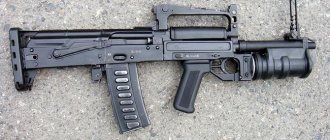C-130 Hercules Dimensions. Engine. Weight. Story. Range of flight
The Lockheed C-130 Hercules was developed according to the international project of a multi-role transport aircraft. The first production contract for the C-130 variant was issued in September 1952. The first prototype YC-130 flew on August 23, 1954. The aircraft had a configuration that is now considered typical for military transport aircraft - a high wing for full use the internal volume of the fuselage and a hydraulically controlled loading and unloading ramp, which in the closed position forms a bevel of the lower surface of the rear fuselage.
History[edit]
Design of the aircraft began at the request of the US Air Force, which was looking for a replacement for the outdated C-119 Flying Boxcar, C-47 Skytrain, and C-46 Commando transports. According to the US Air Force command, based on the experience of the Korean War, the new vehicle had to meet the changing conditions of combat operations. The customers presented the following requirements for the project: the aircraft must accommodate 92 passengers or 72 soldiers with full equipment and weapons or 64 paratroopers with weapons, equipment and parachutes. A flight range of 1,100 nautical miles was required and the ability to continue flying if one engine failed. A separate requirement was the ability to take off from unprepared field airfields.
The C-130 made its first flight on August 23, 1954, from Burbank, California, to Edwards Air Force Base. The flight lasted 61 minutes. Soon after this, she received an order for mass production of the aircraft.
Various modifications of the C-130 have been used in all wars and military conflicts involving the United States, starting with the Vietnam War (except for the bombing of Gaddafi's forces in Libya).
In 1984, an experimental aircraft made its first flight under the HTTB program. Subsequently, based on developments under this program, a deeply modernized transport C-130J “Super Hercules” (or “Hercules-2”) was created, which is currently being produced and operated.
In 2000, Boeing received an order to replace avionics and work to extend the service life of old modifications of the C-130, about 198 aircraft (AMP program). By 2010, the US Department of Defense approved the estimate for modification kits, the cost of work is estimated at $14 million per board, with a total cost of $1.4 billion.
A demilitarized version of the aircraft under the Lockheed L-100 designation has been developed for civilian customers.
Hercules - the most common medium-lift transport aircraft, operated in 65 countries - have been built by Lockheed for more than 50 years. During this time (as of 2009), over 2,300 military transport C-130 and civilian L-100 of various modifications were produced, including about 1,170 for the United States. Unlike its closest analogues - the An-12 and Transal S.160, the Hercules continues to be mass-produced and is in steady demand on the world market.
C-130 Hercules - video
Subsequently, about 60 variants of the C-130 aircraft were created. The main ones are C-130A, B, E and N. 461 aircraft were built in the C-130A and B variants. Various variants of the C-130 aircraft are used not only for military transport, but also to perform special-purpose missions (see list of modifications). Aircraft with an additional letter in the designation were equipped with the appropriate equipment. For example: E - for electronic reconnaissance, control and communications; M - for special operations; K - refueling aircraft in the air: R - for reconnaissance; N - to ensure the search for crews of descending spacecraft, etc.
EC-130E Korenit Solo
Designed for electronic reconnaissance. The main external distinguishing features are large knife antennas under each wing console and above the fork and a smaller horizontal knife antenna on each side of the rear fuselage. On the outer side of each underwing antenna and in the rear part of the tail unit there are bullet-shaped containers with wire antennas several hundred meters long towed behind the aircraft.
MS-130E
Designed for covert landing of airborne sabotage groups behind enemy lines, supplying them and evacuating them from enemy territory. The aircraft crew consists of 9-11 people. The aircraft are equipped with terrain following radar, INS, collimator indicators, a system for dropping cargo from the aircraft and receiving it on board, an interrogating receiver for determining the location of an object, radio stations of the decimeter and meter ranges with frequency modulation, a coded telephone communication system, a retractable container with IR ALQ-8 REP system under the left wing console.
MS-130N
It is the first Air Force heavy aircraft to use displays extensively in its instrumentation. They are adapted to read information from screens using night vision goggles; On display screens, symbols may be superimposed on the image. The following subsystems are also installed on the aircraft: dual INS, forward-looking PC system and dual APQ radar specially developed for the MC-130N aircraft; I70, operating in X-band and Q-band, providing terrain following, mapping and precision navigation. Modifications to the aircraft's airframe include foam-lined fuel tanks, a modified cargo handling system for dropping cargo when the aircraft flies at high speeds at low altitude, and a receptacle for refueling the aircraft in flight.
S-130N-MR
It is a maritime patrol and search and rescue version, created on the basis of the C-130N aircraft. The maximum take-off weight of the S-130N-MR aircraft is 70,310 kg, the maximum transported load is 18,630 kg.
The standard equipment and equipment installed at the request of the customer includes: sea surface surveillance radar. INS, radio navigation system "Omega" with a computer, a device for dropping signal flares, a loudspeaker system, a dropping platform with rescue equipment, a side-view radar, a television camera for low light levels, a PC target detector, a movie camera. The patrol time at an altitude of 1525 m is 2 hours 30 minutes at a distance of 3335 km from the base and 16 hours 50 minutes at a distance of 370 km.
Currently, the production of Hercules aircraft is carried out mainly in the C-130H variant. The fuselage of the S-130N semi-monocoque aircraft is made of aluminum and magnesium alloys. The cargo compartment can accommodate a variety of heavy equipment, such as a 12,080 kg F.6 tank trailer, a 155 mm howitzer or high-speed tractor, or up to five 463L cargo platforms. At the rear of the cabin is the main cargo door and a hydraulically operated loading and unloading ramp. For the release of troops there are two side doors behind the chassis fairing. There is a place for rest for the replacement crew.
The wing is high-mounted, all-metal, of two-spar construction. The chassis is tricycle, with hydraulic drive. The main racks have 2 wheels installed in tandem, and are retracted into fairings on the sides. The power plant consists of four single-shaft engines with an axial compressor and maximum rotor speed. To improve the reliability of the aircraft, a number of changes have been made to the design of many systems and components. There are also differences between variants intended for domestic use and export variants.
S-130K
It is a variant of the C-130N aircraft, modified in accordance with the requirements of the British Air Force. The fuselage of the S-130K aircraft was lengthened by 4.57 m. This made it possible to transport 7 cargo platforms (instead of 5) or 4 Land Rover trucks and 4 trailers (instead of 3 trucks and 2 trailers), or 128 soldiers, or 92 paratroopers with fully equipped, or 97 wounded on stretchers. The first aircraft of this batch was modified in 1979, after which it received the designation “Hercules” S Mk.Z.
US Navy and Marine Corps
The C-130 Hercules first entered service with the US Navy in 1960 when four 130Fs arrived to fly missions in Antarctica. These ski-equipped Hercules were quickly followed by 46 KC-130F models purchased by the Marine Corps in 1962 to serve as attack transport and air tanker roles for fighters and attack aircraft. That same year, the Navy received 7 unequipped C-130Fs for transport missions. The KC-130F made its first test flight in January 1960. The tanker version can refuel 2 aircraft simultaneously with 13,627 liters of fuel from the cargo hold. Fuel is supplied through two removable refueling units located on the underwing pylons.
In 1965, the US Navy's military transport aircraft received several C-130Gs to support Polaris submarines and replace their crews. Like the F model, their structural strength was increased, which allowed them to increase their payload. In all modifications, the cockpit and cargo compartment are sealed and equipped with a refueling and Doppler navigation system. Four of these aircraft were later modified into TACAMO relay aircraft and redesignated EC-130G. After they were replaced by the E-6A, three units were converted into transport (albeit without a cargo ramp) TC-130G.
Another model, the EC-130Q, was in service with two VQ squadrons. It was equipped with a radio transmitter and acted as a strategic communications aircraft with ballistic missile submarines.
Performance characteristics of the C-130 Hercules
— First flight: August 23, 1954 - Units produced: more than 2300 (as of 2009)
Cost of C-130 Hercules
— $30.1 million (C-130H, 1998), $66.5 million (C-130J)
Crew of a C-130 Hercules
— 2 pilots
Payload capacity of C-130 Hercules
— 18,955 kg (at +2.5g) — Passenger capacity: 72 soldiers or 64 paratroopers or 74 wounded on stretchers with two accompanying persons
Dimensions C-130 Hercules
— Length: 29.79 m — Wing span: 40.41 m — Height: 11.84 m — Wing area: 162.12 m² — Wing aspect ratio: 10.1 — Wing load: 433.7 kg/m² ( at normal take-off weight) — Chassis track: 4.34 m — Wing profile: NACA 64A318 wing root, NACA 64A412 tips
Cargo compartment dimensions - Length: 12.19 m - Width: 3.12 m - Height: 2.74 m - Useful volume: 128.9 m³
Weight of C-130 Hercules
— Empty weight: 34,274 kg — Curb weight: 53,230 kg (at +2.5g) — Normal take-off weight: 70,305 kg (at typical load) — Maximum take-off weight: 79,380 kg — Fuel weight in internal tanks: 20,819 kg (+ 8506 kg in PTB) - Volume of fuel tanks: 25,552 l (+ 2×5220 l PTB)
Engines C-130 Hercules
— 4 × Rolls-Royce AE 2100D3 turboprop engines — Engine power: 4 × 4591 l. With. (4 × 3424 kW) — Thrust-to-weight ratio: 194.6 W/kg (at normal take-off weight) — Propeller: six-blade Dowty Aerospace R391 — Propeller diameter: 4.11 m
Speed C-130 Hercules
— Maximum permissible speed: 700 km/h at 3050 m — Maximum speed: 645 km/h — Cruising speed: 628 km/h — Stall speed: 185 km/h — Rate of climb: 10.7 m/s — Climb time: 6100 m in 14 minutes. — Take-off length: 1433 m (up to a height of 15 m) — Run length: 777 m (from a height of 15 m with a landing weight of 58,967 kg)
C-130 Hercules flight range
— 5250 km (with a load weighing 18,144 kg)
Practical ceiling C-130 Hercules
— 9315 m (with a flight weight of 66,680 kg)
Variants[edit | edit source]
Military variantsedit | edit source
Significant military variants of the C-130 include:
- C-130A/B/E/F/G/H/T tactical airlifter
- AC-130A/E/H/U gunship
- JC-130 and NC-130 temporary and permanent conversion for flight test operations
- PC-130 maritime patrol
- RC-130 reconnaissance
- SC-130 search and rescue
- TC-130 aircrew training
- VC-130 VIP transport
- C-130K Hercules design for Royal Air Force Hercules C1/C2/C3 aircraft
Civilian variantsedit | edit source
- L-100 – Civilian version, equivalent to the C-130E
- L-100-20 – Civilian version, stretched 8.3 ft (m {`4`})
- L-100-30 – Civilian version, stretched 15 ft (m {`4`})
Construction[edit]
The aircraft is built according to the classic design for transport aircraft - a high-wing aircraft, with four turboprop engines, and a high-mounted tail unit. The fuselage is round in cross-section with a large loading hatch in the rear section.
The chassis is three-wheeled, with a front strut: on the front there is a pair of wheels, on the main struts there are also two wheels, but not paired, but tandem.
In the airborne transport version, the aircraft crew consisted of two pilots, a navigator, an on-board technician and a loading and landing technician. In the future, the crew composition depended on the specific modification, from 2-3 (C-130J) to 13 (AC-130U).
Powerplantedit
A new Allison T56 turboprop engine with a maximum power of up to 4100 hp was developed specifically for the aircraft, mass production of which began in 1954. The T-56 underwent several dozen modifications during production. In addition to the C-130, it was installed on a number of airplanes and helicopters, as well as on warships of the US Navy as an autonomous power unit under the symbol “501K”. The civil version of the engine for commercial aircraft is called “501-D”.
New modifications of the C-130 are equipped with Rolls-Royce AE 2100 engines.
The aircraft has been in production for a long time and has a lot of different modifications, which differ quite significantly from each other, maintaining only the general layout. In particular, the chassis and fuel system were improved, including the installation of an in-flight refueling system. Electronic equipment was repeatedly changed and more advanced engines were installed. Several specialized modifications of the aircraft were produced, in addition to transport - search and rescue, tankers, repeaters, reconnaissance aircraft, jammers, fire support aircraft, missile telemetry aircraft and many others.
The most advanced modification of the transport version of the C-130J
, which is in service, received new power plants with six-blade propellers, completely updated electronic equipment, including a satellite navigation system. Two pilots are now sufficient to control the aircraft; the cockpit is equipped with multifunctional LCD displays and a heads-up display system. A set of works was carried out to simplify aircraft maintenance at an off-base airfield, which made it possible to exclude technicians from the crew; in particular, it was possible to replace landing gear wheels without airfield maintenance facilities. Landing transport and loading equipment has been modified.
Unlike the basic version, the C-130J is equipped with a fully remote EDSU aircraft control system, the control surfaces are slightly improved, the tail surface is changed, and double-slotted flaps and spoilers are used.
Application in combat points:
On September 2, 1958, while conducting a spy flight over the territory of Armenia, the reconnaissance version of the S-130 aircraft came under fire from Soviet MiG-17 fighters, as a result of which it was shot down.
In 1963, the possibility of basing this aircraft on aircraft carriers was tested. Tests on the USS Forrestal were successful.
Vietnam War
In Vietnam, C-130s were used as transport workers, strike aircraft gunners, tankers, reconnaissance aircraft, air command centers for control and coordination of bombers during the bombing of North Vietnam, and fire support aircraft for ground forces (AC-130 Specter).
US losses in this war were 55 C-130s, 4 KC-130s and 6 AC-130s. One of the Hercules fell from being hit by two 37 mm caliber shells. The losses of the South Korean side during this time amounted to at least 8 Hercules. Also, 7 vehicles were acquired by the North Vietnamese as trophies.
Further combat use
In 1964, a group of Lockheed C-130 Hercules aircraft were used to free hostages in the town of Stanleyville (Belgian Congo).
Indo-Pakistani War
During this military conflict, C-130 aircraft were at the disposal of the Pakistani Air Force. At least one combat Hercules was lost due to technical reasons.
Falklands War
Argentine C-130s flew night patrols in the Falkland Islands, transporting army personnel and supplying fuel to Argentine Skyhawks and Super Etandars that carried out raids on British ships. One of the fighters was shot down by a British Harrier fighter. The crew of seven people failed to escape.
Angolan Civil War
Various modifications of the C-130 Hercules aircraft were actively used by all parties to the conflict. The American CIA was the supplier of aircraft equipment for both warring parties. During the conflict, 14 C-130 Hercules aircraft of various modifications were shot down, with eight to ten aircraft destroyed on the ground.
Also, the Lockheed C-130 Hercules was actively used during military conflicts in Western Sahara, Iran, Iraq and the Persian Gulf countries. Under the auspices of NATO and the UN, peacekeeping operations were carried out in the countries of the Balkan Peninsula.
Increased efficiency
The company is trying to improve the quality factor of the Lockheed C-130, and with it the fuel efficiency, by increasing the lift and reducing the drag of the aircraft. Success was achieved through microstabilizers, winglets and a lift force distribution system.
Microstabilizers are small strips on the fuselage that reduce natural turbulence. They reduce the load on the hull and make it possible to attack tail streams in places inaccessible to traditional stabilizers.
The lift distribution system improves the Lockheed C-130's quality factor by raising the ailerons to relieve the console, shifting the load toward the center, and reducing the need for fuel to reduce wing camber. Thanks to this, it was possible to increase the maximum cargo weight in the C-130H by 21% and in the C-130J by 10%.
The design of the tip airfoil, or winglet, also helps reduce drag and improve the Lockheed C-130's drag factor. This results in 1-3% fuel savings or a 4% increase in range for the C-130J.
Other mutants
In the mid-50s, no one doubted that the atom would be used everywhere, including in aviation. In 1954, at the dawn of the Hercules, Lockheed engineers drew a sketch of the C-130 with a nuclear reactor. They planned for this variant to be produced in small quantities along with the regular Hercules and used for special operations or other special needs.
But the plans remained plans.
Atomic S-130
In 1991, Vout was working on the issue of radically increasing the flight range of existing aircraft. One of the test subjects was the S-130, which received an extended fuselage and a wing with a span of 85 meters. With its help, they wanted to carry out extra-long patrols or deploy peacekeepers to places far removed from American bases.
Unfortunately, the fate of the project remained secret.
project VLR-131 of the Vout company, developed as part of the Stork program
All this is just a small part of the known projects based on the S-130. And it’s hard to even imagine how many discoveries the further study of the archives prepares! In addition, there is every chance that in the future something radically new may be sculpted on its basis; the old man will show himself in an unexpected way. In any case, he has already flown from an aircraft carrier.
How about taking off vertically? That's possible too!
The problem with the airfield can be solved not only by landing on water. It’s much more interesting to take Hercules and teach it to take off vertically - or at least reduce the length of the takeoff run. The second, of course, was simpler - we put more powerful engines on the C-130, and the goal was achieved!
In 1975, North American developed a project to install four GE F101 turbojet engines on the C-130. But the attempt to snatch the military order from under Lockheed’s nose did not work out. Although the takeoff run was significantly reduced, the engines ate too much - either the range decreased, or the payload was reduced when additional tanks were installed.
North American NA-382
In 1982, the Lockheedites themselves repeated a similar attempt. The S-130 USBHercules not only received new turbojet engines, but also a new wing with the ability to place nacelles above it - just like the YC-14. But the military opted for a more traditional modernization option, which in the future became the C-130J.
S-130 USB. Don’t be alarmed, only the model is asymmetrical - this is done for clarity
But if you install special lifting motors, everything can work out! In 1967, General Motors designed a special outboard nacelle with seven XJ99 engines. The takeoff run was supposed to be reduced to 70-100 meters, but, as additional calculations showed, excessive load could seriously damage the wings.
S-130 with installation of XJ99 lift engines
In 1990, Boeing and NASA developed a VTOL (vertical take-off and landing aircraft) project with a rotary wing based on the C-130. The idea was extremely interesting, but it came at the wrong time. Military budgets were mercilessly cut, and no one gave money for new research.
VTOL based on the C-130 from Boeing and NASA
In 2005, the small company Groen Brothers Aviation decided to go back in time and revive the forgotten class of gyroplanes (rotor-wing aircraft that use a free-rotating rotor for lift and flight). They proposed converting the C-130 aircraft into a similar device. In their opinion, this would allow for an almost vertical landing and take-off within a hundred meters. Alas, the project did not go beyond cool pictures and 3D models.
Green Girolifter"
Modifications:
| S-130A | Based on the Lockheed Model 82 prototype. |
| S-130A-II | For special electronic transactions |
| AS-130A | Attack aircraft based on the JC-130A Gunship II class |
| AC-130A Plain Jane | Attack aircraft with APQ-136 radar |
| AC-130A Surprise Package | Attack aircraft with APN-59N, APQ-133 and AVQ-17 radars, with ASD-5 Black Crow vehicle search system |
| AC-130A Pave Pronto | Strike aircraft with ALQ-87 electronic warfare system and 2 SUU-42A/A reflector launchers. |
| DC-130A (GC-130A) | Target transport aircraft |
| JС-130А | Research aircraft with APS-42 radar. |
| NC-130A | Research modification |
| RC-130A | Photo reconnaissance aircraft. |
| TS-130A | Crew training aircraft. |
| S-130V | Improved design with more powerful T56-A-7 and 7A turboprop engines. |
| NS-130V | Coast Guard aircraft based on the C-130B. |
| R8V-1G | Original designation for the HC-130B in the US Navy. |
| WC-130V | Weather reconnaissance aircraft |
| RC-130V | Reconnaissance aircraft for the Sun Valley II program. |
| S-130V-II | Initial designation RC-130B. |
| JС-130V | Missile tracking aircraft. |
| KS-130V | Aircraft tanker. |
| NC-130V | Experimental short take-off and landing aircraft with theater YT56-A-6. |
| С-130D | Practical version of the S-130A with a combined wheel-ski landing gear. |
| S-130E | The third modification of the aircraft in 1962 based on the Lockheed Model 382 prototype with APQ-122(V) radar |
| S-130E-I | Special Forces aircraft with the STAR (Suface To Air Recovery) rescue system. |
| AC-130E | Modifications of the AC-130A Pave Pronto strike aircraft with weapons and electronics. |
| AC-130E Pave Aegis | Attack aircraft built in 1971 with 2 7.62 mm Minigun machine guns, 2 20 mm M61A1 cannons and 2 40 mm Bofors cannons or a 105 mm recoilless howitzer. |
| AC-130E Pave Specter I | Convoy destroyer attack aircraft with APN-59N and AVQ-17 radars |
| DC-130E | Aircraft for launching and controlling 4 UAVs. |
| EC-130E | Coastal Defense aircraft with LORAN system. |
| MC-130E Combat Talon I | Special Forces aircraft. |
| WC-130E | Hurricane search and weather reconnaissance aircraft. |
| S-130F | Aircraft equipped to serve Navy missions. |
| GV-1U | Original designation for the C-130F in the US Navy. |
| KS-130F | Airplane tanker |
| GV-1 | Original designation for the KC-130F in the US Navy. |
| LC-130F | Antarctic version of the C-130F. |
| UV-1L | Original designation for the LC-130F in the US Navy. |
| S-130G | Modification of the C-130F with the T56-A-16 theater. |
| EC-130G | Electronic communications aircraft with nuclear submarines with the TACAMO II system. |
| S-130H | Export version of the aircraft produced since 1965. |
| S-130H(AEH) | A flying hospital for 52 stretchers, commissioned by the Saudi Arabian Air Force. |
| AC-130H Specter | Modification of the AS-130E attack aircraft. |
| DC-130H | Aircraft launch and control 4 UAVs. |
| EC-130H | Electronic control aircraft using the Compass Call II system. |
| KS-130H | Aircraft tanker. |
| LC-130H | Arctic National Guard aircraft. |
| MS-130H Combat Talon II | Special Forces aircraft. |
| RS-130H | A patrol aircraft commissioned by the Indonesian and Malaysian navies. |
| S-130H-MR | Initial designation RS-130H. |
| RC-130H | Reconnaissance aircraft for the Moroccan Navy. |
| VC-130H | VIP transport for the Saudi Air Force. |
| WC-130H | Weather reconnaissance aircraft, now used as a transport aircraft. |
| S-130H-30 | Modification based on the civilian version of L-100-30. |
| S-130J | Variant of the aircraft with 2 pilots and 4 theaters of Allison GMA2100 (T56-IV). |
| S-130K | Modification of the C-130H for the Royal Air Force with the T56-A-15 theater. |
| Hercules C.Mk.I | The first modification of the S-130K, produced in 1966. |
| Hercules W.Mk.I | Weather reconnaissance aircraft based on Hercules C.Mk.I. |
| Hercules C.Mk.III | 1985 modification of the Hercules C.Mk.I aircraft according to the C-130N-30 standard. |
| NS-130N | A specialized aircraft for receiving data from satellites. |
| EC-130Q | An upgraded version of the EC-130G with the TACAMO system. |
| KS-130R | Tanker aircraft for the Marine Corps. |
| S-130T | Modification made in 1991 with the T56-A-423 turboprop engine. |
| AC-130U | Attack aircraft based on AS-130N |
| EU-130V | Coastal defense aircraft based on the NS-130N with the APS-145 radar to combat drug smuggling. |
| L-100 | Civil version of the S-130E with Allison 501-D22 theater engine |
Cargo compartment
The C-130 can carry more than 19,051 kg of cargo. Floor rollers allow for quick and easy handling of freight pallets and can be removed to leave a flat surface if required. Five pallets (plus an entry baggage tray) can be loaded onto the aircraft through the hydraulically operated main ramp door located at the rear of the aircraft. The ramp can also be lowered to the ground for loading and unloading wheeled vehicles. Tie-down fittings for securing cargo are located throughout the compartment.
As a passenger aircraft, the C-130 Hercules can accommodate 92 soldiers or 64 fully equipped paratroopers in the outboard seats. In its role as an air ambulance, it can transport 74 stretchers with sick and wounded people, as well as two medical workers.
Vivendi Timeline[edit | edit source]
The C-130 Hercules is used by FEAR for Rowdy Betters, as an airborne command center where he briefs the second FEAR team before they HALO drop in and deploy just inside of the Fairport Quarantine Zone, touching down in the flood canals. One is witnessed going down in FEAR Extraction Point
by the Point Man, Jin Sun-Kwon, and Douglas Holiday, and later the Point Man comes across the wreckage.
The same plane is also seen by the Sergeant, after exiting the Subway in F.EAR Perseus Mandate
.
Its not known that crashed C-130 seen in both Extraction Point
and
Perseus Mandate
belongs to FEAR or not, because Rowdy Betters is still alive towards the end of these games, he was not aboard that crashed C-130. The crashed C-130 has “US Air Force” mark on it, this means this C-130 belongs to unknown branch of US Air Force, either shot down by Replica Force or the plane is downed by influence of Alma Wade.
